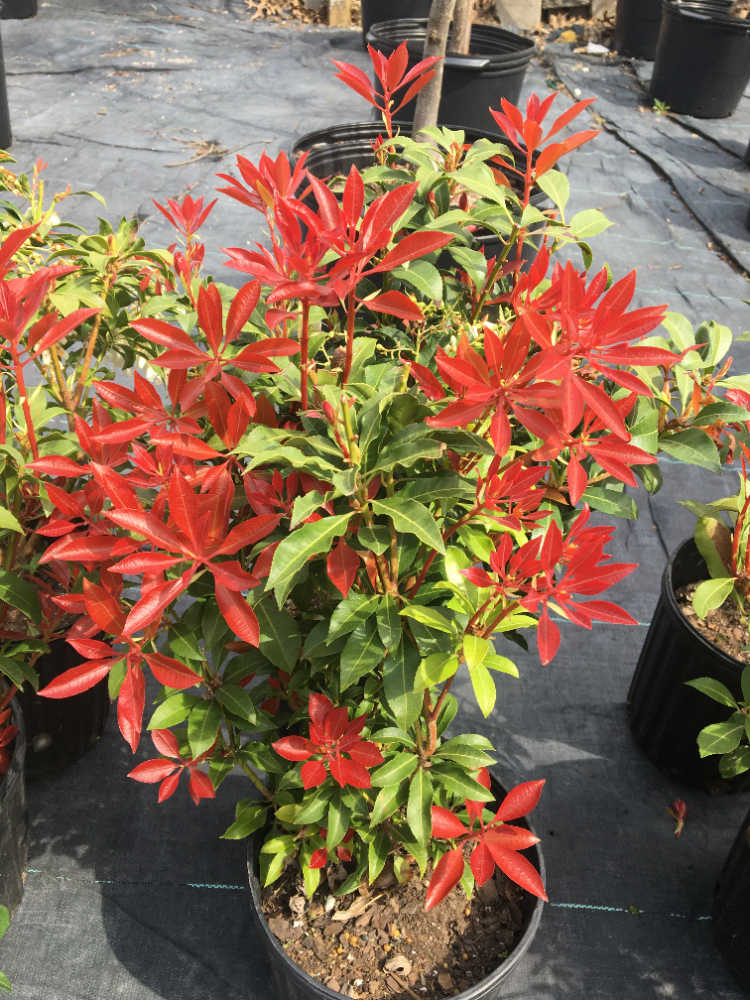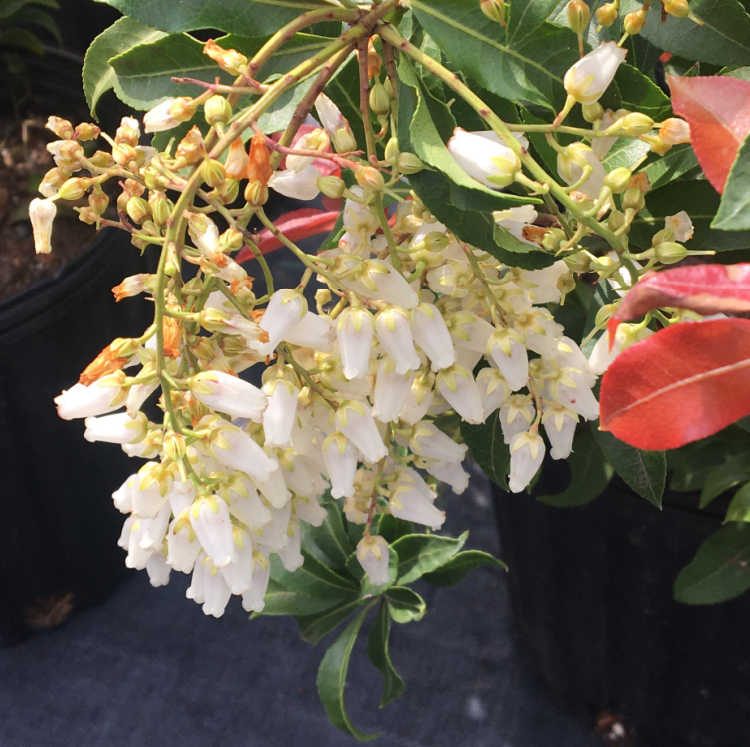
Mountain Fire Piers Japonica is a broad leaf evergreen. This particular variety is famous for the fire red new growth that comes out in the spring, thus the name. Piers Japonica can grow quiet tall, as tall as 8′, they are relatively slow growing and can easily kept to a more manageable size of about 36″ to 40″.

The foliage is very multi colored and changes as the new leaves mature.
The true highlight of any piers japonica are the chain like blooms that appear in the spring.
Piers Japonica are considered deer resistant, they happily grow in zones 5 through zone 8.

They also do well in full sun or partial shade. Because they are an evergreen they make a nice back drop in a landscape planting where lower growing plants can be used in front of them.
They love well drained soil but can be quite happy in clay as well as long as the soil is not soggy all the time.
Questions, comments, mean things to say? Post them below and I will respond. Until then, by any and all means stay inspired!
I have done a lot of cuttings on the Pieris over the years. I do it after they bloom, cut off the old blooms, and take cuttings of new shoots, about 4″ long, remove the bottom leaves and I just put the stem cutting in good garden soil, keep watered all summer. By fall they are usually rooted. A few do not make it, but the cost is free, and I love to experiment.
Darlene
Darlene,
That’s awesome! Thanks for sharing.
You really should correct the spelling of the plants’ name: it is called Pieris, not Piers
Hi Mike,
What shrub would your suggest that is red and small like barberry but does not have the thorns like barberry.? I am replacing 4 small evergreen shrubs that I keep trimmed about 30 inches high and in a circle about 2 feet across. One has died out and the other three don’t look good anymore. They are about 28 years old and we live in the Kansas City area for zone. Was thinking maybe going with Loropetalum – Chinense variety Crimson Fire, I guess these are more purple. Thanks, Walt
Walter,
The Loropetalum would be fine or Java Red Weigela. Red leaves and compact like barberry? Nothing that I can think of.
Loropetalum is good if you want it fast! . . . and terrible if you don’t want it to take over. Great solution for someone who is training to be a professional “pruner.”
Re: Piers Japonica
This was in our neighborhood news letter and I thought the two plants looked alike so I destroyed 3 in my yard. Then saw your post and wondered about it. But I see the names are completely different. Look very similar.
A plant that’s killing songbirds. This plant is killing songbirds across North America! If you have one or see one with berries, cut off the berries and compost them. Nandina domestica (heavenly bamboo) is from China and so our birds mistake it for a food source. The seeds contain a ton of cyanide and cause a swift and extremely painful death. Such a simple thing could save hundreds of lives. https://www.ncbi.nlm.nih.gov/pmc/articles/PMC3005831/
https://d3926qxcw0e1bh.cloudfront.net/post_photos/49/3c/493c7cb2cb07d2be89585e84caa045b6.jpeg
Hi , Just potted up the Mountain Fire Piers Japonica and now it has a bunch of soft cuttings ready to pick in June and maybe I can get a few to root.
Thanks for the tip.
Enjoyed the vidio.
Hi – saw your post and have a question. I am looking for 3 Mountain Fire Piers Japonica plants. My question – would you be willing to sell me 3 of your cuttings once they are rooted? Thank you.
Ken,
I don’t ship any plants at all.
Hi Mike,
We have two of these in our landscape. Is there a propagation method you might recommend? Best time of year to take cuttings and what not?
Best regards,
Mike Kinnes
Mike,
Piers are really in the Rhododendron family and that makes them a bit tricky to root. Try softwood cuttings in the summer. http://mikesbackyardnursery.com/2015/01/easy-summertime-plant-propagation-techniques-can-home/, if that doesn’t work you can try them as hardwoods over bottom heat. Or try that now.
Thank you Mike, that is good to know,
Based on what you said I just did a search for bottom heat and your article on Home Gardening and Electricity popped up. Great article. I am a licensed Electrical Contractor in multiple states in New England and that article is an important one for anyone to consider when working around areas of high humidity and potential wetness as a grow areas can be. I like your advice on GFCI protection and the things not to do.
Do you have a preferred heater you recommend for creating bottom heat?
Mike,
Commercial heat mats that are thermostatically controlled are probably the best. For larger indoor areas you can make heat with a water heater and a recirculating pump. There are you tube videos about making bottom heat with a fish tank heater in a bucket and a pump but I have no idea how well that works.
Planted one of these about 10 years ago. Still about 3 ffetts\all. Why doesn’t it grow?
Carol,
They are evergreen and slow growing. If the soil is wet and sticky it will grow even slower. Loves well drained soil.